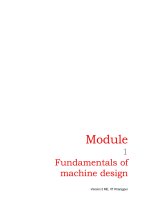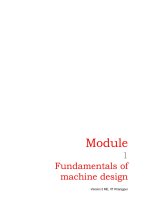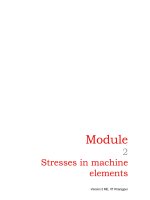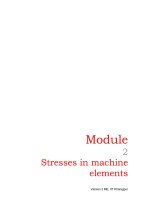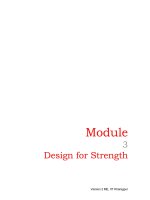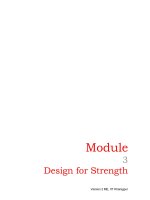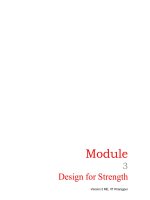Tài liệu Fundamentals of Machine Design P22 docx
Bạn đang xem bản rút gọn của tài liệu. Xem và tải ngay bản đầy đủ của tài liệu tại đây (143.07 KB, 11 trang )
Module
8
Design of Shaft
Version 2 ME , IIT Kharagpur
Lesson
1
Shaft and its design
based on strength
Version 2 ME , IIT Kharagpur
Instructional Objectives:
At the end of this lesson, the students should be able to understand:
Definition of shaft
Standard shaft sizes
Standard shaft materials
Design of shaft based on strength
8.1.1 Shaft
Shaft is a common and important machine element. It is a rotating member, in
general,
has a circular cross-section and is used to transmit power. The shaft may be
hollow or solid. The shaft is supported on bearings and it rotates a set of gears or
pulleys for the purpose of power transmission. The shaft is generally acted upon
by bending moment, torsion and axial force. Design of shaft primarily involves in
determining stresses at critical point in the shaft that is arising due to
aforementioned loading. Other two similar forms of a shaft are axle and spindle.
Axle is a non-rotating member used for supporting rotating wheels etc. and do
not transmit any torque. Spindle is simply defined as a short shaft. However,
design method remains the same for axle and spindle as that for a shaft.
8.1.2 Standard sizes of Shafts
Typical sizes of solid shaft that are available in the market are,
Up to 25 mm 0.5 mm increments
25 to 50 mm 1.0 mm increments
50 to 100 mm 2.0 mm increments
100 to 200 mm 5.0 mm increments
8.1.3 Material for Shafts
The ferrous, non-ferrous materials and non metals are used as shaft material
depending on the application. Some of the common ferrous materials used for
shaft are discussed below.
Hot-rolled plain carbon steel
These materials are least expensive. Since it is hot rolled, scaling is always
present on the surface and machining is required to make the surface smooth.
Version 2 ME , IIT Kharagpur
Cold-drawn plain carbon/alloy composition
Since it is cold drawn it has got its inherent characteristics of smooth bright finish.
Amount of machining therefore is minimal. Better yield strength is also obtained.
This is widely used for general purpose transmission shaft.
Alloy steels
Alloy steel as one can understand is a mixture of various elements with the
parent steel to improve certain physical properties. To retain the total advantage
of alloying materials one requires heat treatment of the machine components
after it has been manufactured. Nickel, chromium and vanadium are some of the
common alloying materials. However, alloy steel is expensive.
These materials are used for relatively severe service conditions. When the
situation demands great strength then alloy steels are used. They have fewer
tendencies to crack, warp or distort in heat treatment. Residual stresses are also
less compared to CS(Carbon Steel).
In certain cases the shaft needs to be wear resistant, and then more attention
has to be paid to make the surface of the shaft to be wear resistant. The common
types of surface hardening methods are,
Hardening of surface
Case hardening and carburizing
Cyaniding and nitriding
8.1.4 Design considerations for shaft
For the design of shaft following two methods are adopted,
Design based on Strength
In this method, design is carried out so that stress at any location of the shaft
should not exceed the material yield stress. However, no consideration for shaft
deflection and shaft twist is included.
Design based on Stiffness
Basic idea of design in such case depends on the allowable deflection and twist
of the shaft.
Version 2 ME , IIT Kharagpur
8.1.5 Design based on Strength
The stress at any point on the shaft depends on the nature of load acting on it.
The stresses which may be present are as follows.
Basic stress equations :
Bending stress
b
3
0
32M
d(1 k)
σ=
π−
4
(8.1.1)
Where,
M : Bending moment at the point of interest
d
o
: Outer diameter of the shaft
k : Ratio of inner to outer diameters of the
shaft ( k = 0 for a solid shaft because inner diameter is zero )
Axial Stress
a
2
0
4F
d(1 k)
α
σ=
π−
2
(8.1.2)
Where,
F: Axial force (tensile or compressive)
α
: Column-action factor(= 1.0 for tensile load)
The term
α
has been introduced in the equation. This is known as column action
factor. What is a column action factor? This arises due the phenomenon of
buckling of long slender members which are acted upon by axial compressive
loads.
Here,
α
is defined as,
1
for L/K < 115
1 0.0044(L/ K)
α =
−
Version 2 ME , IIT Kharagpur
2
yc
2
L
for L/K > 115
nE K
σ
⎛⎞
α =
⎜⎟
π
⎝⎠
(8.1.3)
Where,
n = 1.0 for hinged end
n = 2.25 for fixed end
n = 1.6 for ends partly restrained, as in bearing
K = least radius of gyration, L = shaft length
yc
σ
= yield stress in compression
Stress due to torsion
xy
3
0
16T
d(1 k)
τ=
π−
4
(8.1.4)
Where,
T : Torque on the shaft
xy
τ
: Shear stress due to torsion
Combined Bending and Axial stress
Both bending and axial stresses are normal stresses, hence the net normal
stress is given by,
(8.1.5)
The net normal stress can be either positive or negative. Normally, shear stress
due to torsion is only considered in a shaft and shear stress due to load on the
shaft is neglected.
Maximum shear stress theory
x
34
0
32M
[
d(1 k)
σ= ±
π−
22
0
4F
]
d(1 k)
α
π−
Version 2 ME , IIT Kharagpur
Design of the shaft mostly uses maximum shear stress theory. It states that a
machine member fails when the maximum shear stress at a point exceeds the
maximum allowable shear stress for the shaft material. Therefore,
(8.1.6)
2
2
x
max allowable xy
2
σ
⎛⎞
τ= =
⎝⎠
τ +τ
⎜⎟
Substituting the values of σ
x
and τ
xy
in the above equation, the final form is,
2
2
2
0
allowable
34
0
Fd (1 k )
16
M
d(1 k) 8
⎧⎫
α+
τ= + +
⎨
π−
⎩⎭
T
⎬
(8.1.7)
Therefore, the shaft diameter can be calculated in terms of external loads and
material properties. However, the above equation is further standarised for steel
shafting in terms of allowable design stress and load factors in ASME design
code for shaft.
8.1.6 ASME design Code
The shafts are normally acted upon by gradual and sudden loads. Hence, the
equation (8.1.7) is modified in ASME code by suitable load factors,
2
2
2
0
allowable bm t
34
0
Fd (1 k )
16
CM (CT)
d(1 k) 8
⎧⎫
α+
τ= + +
⎨⎬
π−
⎩⎭
(8.1.8)
where, C
bm
and C
t
are the bending and torsion factors. The values of these
factors are given below,
C
bm
C
t
For stationary shaft:
Load gradually applied 1.0 1.0
Load suddenly applied 1.5 - 2.0 1.5 - 2.0
For rotating shaft:
Load gradually applied 1.5 1.0
Version 2 ME , IIT Kharagpur
Load suddenly applied
(minor shock) 1.5 - 2.0 1.0 - 1.5
Load suddenly applied
(heavy shock) 2.0 - 3.0 1.5 - 3.0
ASME code also suggests about the allowable design stress, τ
allowable
to be
considered for steel shafting,
ASME Code for commercial steel shafting
= 55 MPa for shaft without keyway
= 40 MPa for shaft with keyway
ASME Code for steel purchased under definite specifications
= 30% of the yield strength but not over 18% of the ultimate
strength in tension for shafts without keyways. These values are to be reduced
by 25% for the presence of keyways.
The equations, (8.1.7) and (8.1.8) are commonly used to determine shaft
diameter.
Sample problem
The problem is shown in the given figure. A pulley drive is transmitting power to a
pinion, which in turn is transmitting power to some other machine element. Pulley
and pinion diameters are 400mm and 200mm respectively. Shaft has to be
designed for minor to heavy shock.
200
m
400
m
200
m
4000 N
1000 N
6000 N
2200 N
W=1000 N
Pinion
Pulle
y
Bearin
g
Solution
From the given figure, the magnitude of torque,
3
T (4000 1000) 200 N mm 600 10 mm=−× =× Ν
Version 2 ME , IIT Kharagpur
It is observed that the load on the shaft is acting both in horizontal and vertical
planes. The loading diagram, corresponding bearing reactions and bending
moment diagram is given below.
A C D B
Horizontal plane
Vertical plane
Loading and Bending Moment Diagram
860 Nm
580Nm
- 150 Nm
5000 N
2200N
1000N
6000N
AV
R
AH
R
BV
R
BH
R
- 850Nm
The bending moment at C:
For vertical plane, M
V
: -150 Nm
For horizontal plane, M
H
: 860 Nm
Resultant moment: 873 Nm
The bending moment at D:
For vertical plane, M
V
: -850 Nm
For horizontal plane, M
H
: 580 Nm
Resultant moment: 1029Nm
Therefore, section-D is critical and where bending moment and torsion is 1029
Nm and 600 Nm respectively.
ASME code for shaft design is suitable in this case as no other specifications are
provided. In absence of any data for material property, the allowable shear for
commercial steel shaft may be taken as 40 MPa, where keyway is present in the
shaft.
For the given codition of shock, let us consider C
bm
= 2.0 and C
t
= 1.5.
Version 2 ME , IIT Kharagpur
From the ASME design code, we have,
(
)
(
)
3
32
obmt
d
3
22
o
16 10
d (C 1029) (C 600)
16 10
(2.0 1029) (1.5 600)
40
d mm 66mm
×
=×+×
τ×π
×
= × + ×
×π
2
∴
= 65.88 ≈
From standard size available, the value of shaft diameter is also 66mm.
Questions and answers
Q1. What do you understand by shaft, axle and spindle?
A1. Shaft is a rotating member, in general, has a circular cross-section and is
used to transmit power. Axle is a non-rotating member used for supporting
rotating wheels etc. and do not transmit any torque. Spindle is simply
defined as a short shaft.
Q2. What are the common ferrous materials for a shaft?
A2. Common materials for shaft are, hot-rolled plain carbon steel, cold-drawn
plain carbon/alloy composition and alloy steels.
Q3. How do the strength of a steel material for shafting is estimated in ASME
design code for shaft?
A3. Material property for steel shaft for ASME code is as follows,
For commercial steel shafting
= 55 MPa for shaft without keyway
= 40 MPa for shaft with keyway
For steel purchased under definite specifications
= 30% of the yield strength but not over 18% of the ultimate
strength in tension for shafts without keyways. These values are to be reduced
by 25% for the presence of keyways in the shaft.
Version 2 ME , IIT Kharagpur
References
1. J.E Shigley and C.R Mischke , Mechanical Engineering Design , McGraw Hill
Publication, 5
th
Edition. 1989.
2. M.F Spotts, Design of Machine Elements, Prentice Hall India Pvt. Limited, 6
th
Edition, 1991.
3. Khurmi, R.S. and Gupta J.K., Text book on Machine Design, Eurasia
Publishing House, New Delhi.
4. Sharma, C.S. and Purohit Kamalesh, Design of Machine Elements, Prentice
Hall of India, New Delhi, 2003.
Version 2 ME , IIT Kharagpur
